
Drag hunting or draghunting is a form of equestrian sport, where mounted riders hunt the trail of an artificially laid scent with hounds.

Drag hunting or draghunting is a form of equestrian sport, where mounted riders hunt the trail of an artificially laid scent with hounds.
Drag hunting is an equestrian sport where a field of mounted riders chase a pack of hounds who follow or 'hunt' a trail of an artificial non-animal based scent. The primary difference between fox hunting and drag hunting is the hounds are trained to chase a prepared scent trail laid by a person dragging a material soaked in aniseed or another strong-smelling substance and not an animal-based scent mimicking a fox hunt, as in trail hunting. [1] [2]
A drag hunt course is set in a similar manner to a cross country course, following a predetermined route over jumps and obstacles. Because it is predetermined, the route can be tailored to suit the riding abilities of the field. The scent, or line, is usually laid 10 to 30 minutes prior to beginning of the drag hunt and there are usually three to four lines, of approximately 2 mi (3.2 km) each, laid for a day of drag hunting. [1] [2]
The drag hunting season usually starts in mid-October and continues through autumn and winter, finishing in the spring. [1]
Drag hunting first became popular in the 19th century when Oxford and Cambridge universities both established packs of drag hounds. [1]
The Pau Hunt, under the Mastership of Jasper Hall Livingston, documents a drag hunt on Saturday, November 26, 1847 between Pau, France and Gardères on the Route de Tarbes making a distance of 21 km (13 miles) in one hour. [3] [4]
Drag hunting soon became popular with the British Army, with the Household Cavalry establishing a pack in 1863 and the Royal Military Academy Sandhurst and the Royal Military Academy Woolwich both establishing packs in 1870. The motivation of the British Army's interest in the sport was it was seen to provide excellent preparation for beginners and those who were about to enter the cavalry divisions. [1]
As it does not involve the hunting of live animals, drag hunting remained legal in Great Britain after the passing of the Protection of Wild Mammals (Scotland) Act 2002 and the Hunting Act 2004 (England and Wales). [5]
A controversial, [6] alternative to hunting animals with hounds in Great Britain. A trail of animal urine (most commonly fox) is laid in advance of the 'hunt', and then tracked by the hound pack and a group of followers; on foot, horseback, or both.
Similar to drag hunting, but in the form of a race; usually of around 10 mi (16 km) in length. [1] Unlike other forms of hunting, the hounds are not followed by humans.
Clean boot hunting uses packs of bloodhounds to follow the natural trail of a human's scent. [1]

Fox hunting is a traditional activity involving the tracking, chase and, if caught, the killing of a fox, normally a red fox, by trained foxhounds or other scent hounds. A group of unarmed followers, led by a "master of foxhounds", follow the hounds on foot or on horseback.

Scent hounds are a type of hound that primarily hunts by scent rather than sight. These breeds are hunting dogs and are generally regarded as having some of the most sensitive noses among dogs. Scent hounds specialize in following scent or smells. Most of them tend to have long, drooping ears and large nasal cavities to enhance smell sensitivity. They need to have relatively high endurance to be able to keep track of scent over long distances and rough terrain. It is believed that they were first bred by the Celts by crossbreeding mastiff-type dogs with sighthounds. The first established scent hounds were St. Hubert Hounds bred by monks in Belgium during the Middle Ages.

Beagling is mainly the hunting of hares and rabbits by beagles using their strong sense of smell. A beagle pack is usually followed on foot, but in a few cases mounted. Beagling is often enjoyed by 'retired' fox hunters who have either sustained too many injuries or lost the agility to ride horseback, or who enjoy the outdoors and the camaraderie of the hunt. It is also traditionally a way for young men and women to learn how to handle hounds on a smaller scale before they go on to hunt with foxhounds.
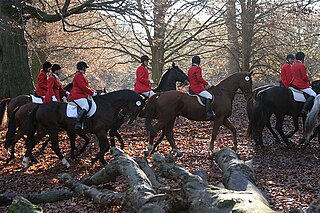
A field hunter, or a fox hunter, is a type of horse used in the hunt field for fox hunting and stag hunting.

The Fox and the Hound is a 1967 novel written by American novelist Daniel P. Mannix and illustrated by John Schoenherr. It follows the lives of Tod, a red fox raised by a human for the first year of his life, and Copper, a half-bloodhound dog owned by a local hunter, referred to as the Master. After Tod causes the death of the man's favorite hound, man and dog relentlessly hunt the fox, against the dual backdrops of a changing human world and Tod's normal life in hunting for food, seeking a mate, and defending his territory. As preparation for writing the novel, Mannix studied foxes, both tame and wild, a wide variety of hunting techniques, and the ways hounds appear to track foxes, seeking to ensure his characters acted realistically.
Hunting the clean boot is a term that has been used in Britain to refer to the use of packs of bloodhounds to follow a natural human scent trail.

The Southern Hound was a breed of dog that existed in Britain probably until sometime in the 19th century, now extinct. The exact date of its extinction is not known; it is likely that it was gradually interbred with other breeds until the genuine Southern Hound bloodline ceased to exist.

The North Country Beagle, Northern Hound or Northern Beagle was a breed of dog that existed in Britain probably until early in the 19th century. The exact date of its extinction is not known; it is likely that it was gradually interbred with other breeds, particularly the modern Beagle, until the genuine North Country Beagle bloodline ceased to exist.
Hound trailing, or hound racing, is a dog sport that uses specially bred hounds to race along an artificially laid scent trail over a cross country course.

The bloodhound is a large scent hound, originally bred for hunting deer, wild boar, rabbits, and since the Middle Ages, for tracking people. Believed to be descended from hounds once kept at the Abbey of Saint-Hubert, Belgium, in French it is called, le chien de Saint-Hubert.

Wolf hunting with dogs is a method of wolf hunting which relies on the use of hunting dogs. While any dog, especially a hound used for hunting wolves may be loosely termed a "wolfhound", several dog breeds have been specifically bred for the purpose, some of which, such as the Irish Wolfhound, have the word in their breed name.
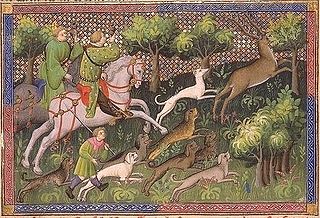
Rache, also spelled racch, rach, and ratch, from Old English ræcc, linked to Old Norse rakkí, is an obsolete name for a type of hunting dog used in Great Britain in the Middle Ages. It was a scenthound used in a pack to run down and kill game, or bring it to bay. The word appears before the Norman Conquest. It was sometimes confused with 'brache', which is a French derived word for a female scenthound.
A limer, or lymer, was a kind of dog, a scenthound, used on a leash in medieval times to find large game before it was hunted down by the pack. It was sometimes known as a lyam hound/dog or lime-hound, from the Middle English word lyam, meaning 'leash'. The French cognate limier has sometimes been used for the dogs in English as well. The type is not to be confused with the bandog, which was also a dog controlled by a leash, typically a chain, but was a watchdog or guard dog.
Trail hunting is a legal, although controversial, alternative to hunting animals with hounds in Great Britain. A trail of animal urine is laid in advance of the 'hunt', and then tracked by the hound pack and a group of followers; on foot, horseback, or both.
Mink hunting is a country sport involving the hunting of American mink with scent hounds along the waterways which make up their habitat, in a manner similar to fox hunting. Mink hunting took place in the countryside in the UK and Ireland, but since 2005 traditional mink hunting has been banned in England and Wales.
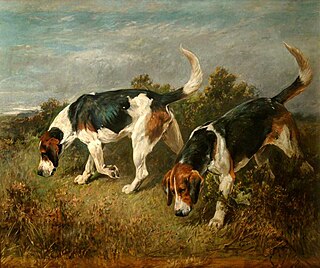
The Buckhound was a breed of now extinct scent hound from England; they were used to hunt fallow deer in packs.

Jasper Hall Livingstone was an American horse owner, gentleman rider and sportsman. He was chargé d'affaires under Ambassador Washington Irving at Madrid and later the Master of the Pau Hounds for 11 non-consecutive winter seasons between 1847 and 1873. He was an innovator of drag hunting and mocked in the development of this "fictitious" sport, while some considered it ideal for young riders or "the impatient and brave who hunted to ride rather than rode to hunt".
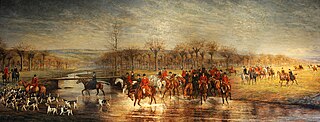
The Pau Hunt was established in 1842 by the Société d’Encouragement as a spectacule authorized by the government of Louis Philippe to hunt predatory animals such as wolves and foxes. Internationally, the Pau Hunt, dominated by American and British Masters, was one of the most renown hunts until the breakout of World War II. Its country, between Gardères and the hills surrounding Pau was nicknamed “Leicestershire in France”.

The legend of the Duke of Wellington at Pau, France, first appeared in a 1907 publication coinciding with the 65th anniversary of the founding of the Pau Hunt, and quickly developed into a tale about the origins of Fox hunting in Béarn. After the Peninsular War, Wellington spent just one night at Pau, May 18, 1814, stopping on the route from Toulouse to Madrid. The tale of a more lengthy and marked presence developed 90 years later as a prank that regular winter colonists played on newcomers. The tale found its way into touristic marketing publications, memoires and academic publications during challenging times. Despite contradictory historical evidence, it has developed into Bearnese folklore. Worldwide, is difficult to find any 21st century historical passage about the 19th century "English" tourist colony at Pau that does not present this legend.
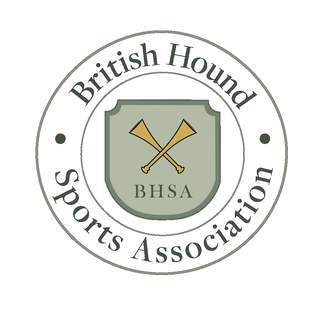
The British Hound Sports Association (BHSA) is the governing body for many hound sports associations in Great Britain. However, it is not the governing body for either draghound packs or bloodhound packs who are governed by the Master of Draghound & Bloodhounds Association (MDBA). The BHSA is responsible for setting standards and rules to which members and registered hunts are supposed to adhere. A sister organisation, the Hound Sports Regulatory Authority (HSRA), is responsible for regulatory and disciplinary matters for members and member hunts, in accordance with rules set by the BHSA.